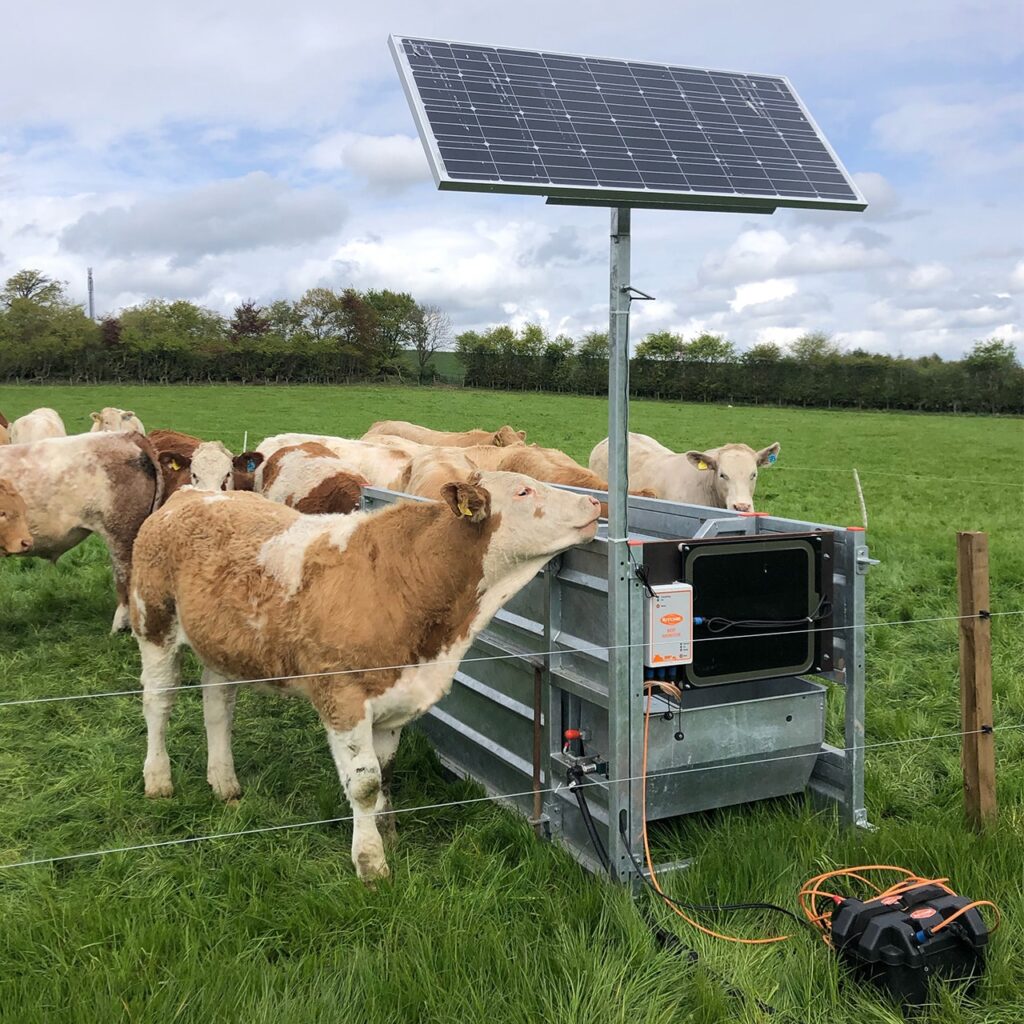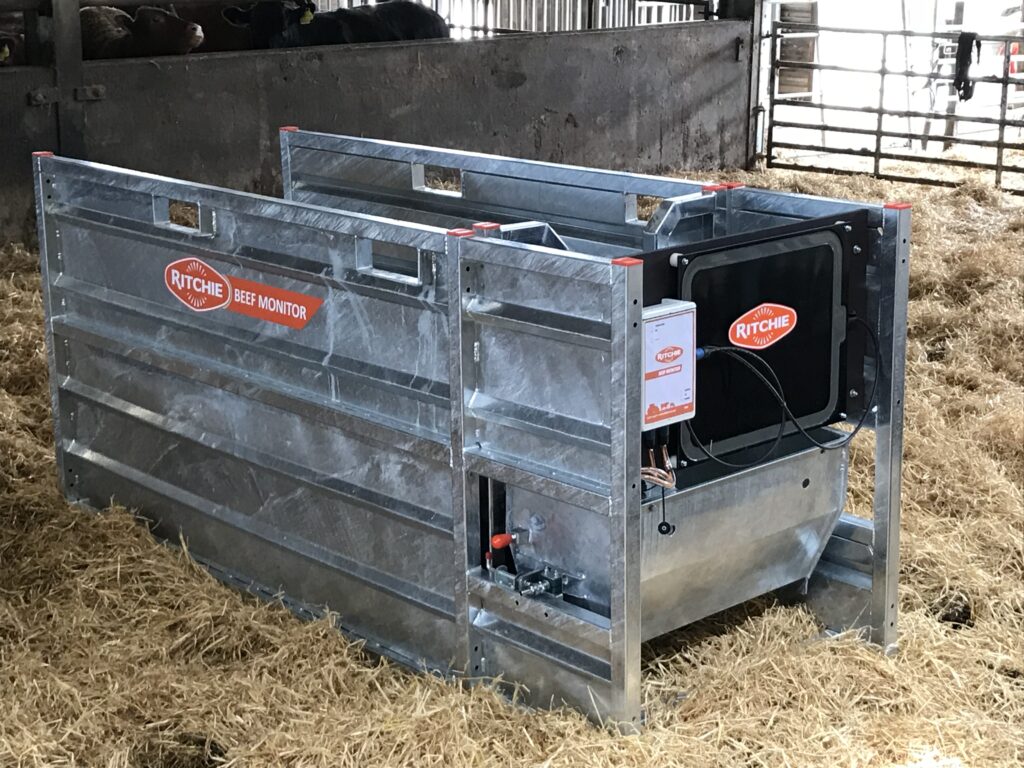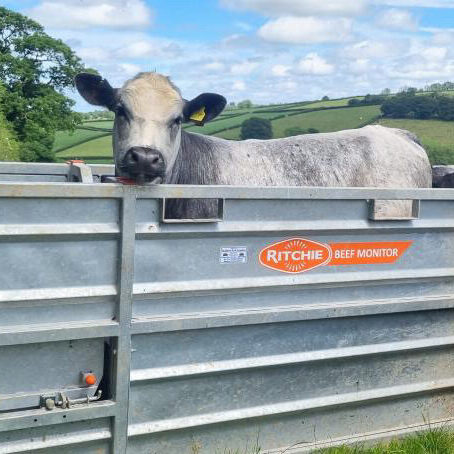The penalties for supplying cattle ‘out of spec’ can be costly. There are professional finishers who will admit that, despite their undoubted skills in weight estimation, they have on occasions been shocked by actual weights. Therefore the need to check weight is necessary.
If regular weighing of beef cattle is the solution, what about the impact of manual weighing on subsequent performance because of the stress involved?
The answer? A system that weighs cattle regularly without the need for manual handling.
Ritchie Beef Monitor


This weigher is a free access crate with load-bar weighing platform. The cattle, carrying EID ear tags, visit several times a day to drink. As they lower their heads to the water, the animals are identified and the weight recorded and transmitted to cloud-based storage.
The Beef Monitor will also work at grass where water is available and with a solar panel power source. The ideal group size whether inside or outside is 50 head, which ensures they all get sufficient water and bullying is minimised.
How it records Weight Gain
However many weighings have been recorded for an individual, they are averaged at the end of each day. This produces both the actual weight and updated daily gain. It is therefore very accurate as it will be a combination of full or empty stomachs and bladders. This data is then stored on the cloud. Farmers can access it from their own dashboard on the Ritchie website via office PC, laptop or a mobile app.
The monitor has the ability to highlight erroneous weights. Occasionally an animal may place a front leg on the weighing platform, but the system recognises this and flags it up as an error. It can also be a good indicator of a potential health problem. If an individual animal stops putting on weight it’ll highlight this.
It does not take long for cattle to find the water provided if all other sources of drinking have been excluded. Within the first 24 hours of introducing them to the Beef Monitor they will all be weighed at least once.
Accuracy of Weight
Iain Green – Corskie Farm, Beef Monitor user – ‘Scotch Beef Farm of the Year’ 2024 Agri Award winner
“We have found that some animals might visit 12 times or so in a 24-hour period but the readings are averaged for the day. They provide us with a very accurate indication of weight on an on-going basis,” states Mr Green.
Like most finishers in Scotland, the Greens sell deadweight. Consequently, to maximise our returns, we need to be hitting abattoir spec with every animal. This system is giving us the accuracy. I could not achieve by eye and without which l’d have to weigh manually. We’ve been weighing pedigree animals conventionally for a long time and I have always liked to think I have a good eye for assessing weight. But I know it is not necessarily so,” says Mr Green.
“What it means is we’re not sending in cattle which will be penalised on being over-weight. In our case 400kg dead weight for our buyer – but also we can take them closer to their target weight safely. The system flags up all animals calculated to be 100kg off finishing.” However, automatic daily weight monitoring also identified something the Greens would not otherwise have known.
Beef Monitor – BM3000 on YouTube
Preventing weight Stagnation due to Handling
“We use Breedplan recording with the British Simmental Cattle Society for the pedigrees. That includes fat depth and eye muscle monitoring by ultrasound. When we did this with a bunch of 32 bulls. The automatic weighings revealed it took between seven to 10 days before these bulls began to put on weight again. We are quite sure this can be put down simply to the stress of being handled,” explains Laura, one of Mr Green’s oldest two daughters. “You just wouldn’t know that was happening. So, anything that can be automated to minimise the need to handle cattle has got to be good for both men and cattle. Reducing the days to slaughter.”
Euan Critchton, also a Beef Monitor user, highlighted the impact of weight stagnation from the stress of being handled. Having moved the cattle from one court to another for mucking out he said:
“We found that it took just under a week before they started to gain weight again. Moving them for less than four hours. Moving them from one shed to another, not even putting them through a crate so I was quite staggered by that.”
Beef Monitor Benefits
It is clear that regular weigh-ins are necessary even for those who consider themselves adept at judging the finishing weight of their cattle. Regular weighing can not only help farmers reach precise finishing weights, but monitor health and learn more about animal welfare to maximise output. Traditional methods of weighing are counter-productive although knowledge is gained, animal weight is lost due to stress. The Ritchie Beef Monitor offers a stress-free solution. Providing real-time, easily accessible data without the need for manual handling—saving time, reducing stress, and enhancing overall efficiency.

